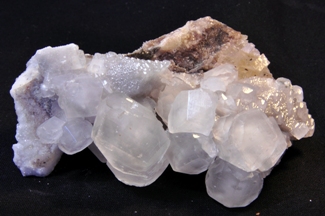A New Interactive Tool for Learning Crystallography

Crystallography is present in our surroundings, from minerals and rocks of the Earth's crust, through all kinds of pharmaceuticals to many technological materials such as metals, semiconductors, ceramics, etc.; all of them are solids with internal structure (at the atomic level) of crystalline type. Despite the ubiquity of the crystalline material and the usefulness of crystallographic methods in many areas, such as the structure determination of biological molecules (as proteins or DNA) to name a current topic, crystallography is still a relatively complicated and somehow weird science to many technologists and scientists.
Our goal is to promote learning and understanding of a fundamental aspect of crystallography, the symmetry. And we have done this through a modern and trilingual (Catalan, Spanish and English) computer tool. This tool is freely available to everyone (http://departaments.uab.cat/geologia/PSG), and it does not require any specialized software (just the widespread Adobe Reader). Specifically, we have developed 32 interactive files in pdf format, one for each of the 32 possible sets of point symmetry elements, named point groups. Point symmetry constitutes the first category of the crystallographic symmetry (there is only another category, the space symmetry) and it is typically connected to the symmetry of finite figures (the crystals forms), although it also exists at the internal structure level. Indeed, traditional learning of this type of symmetry involves the use of wooden polyhedral models that simulate ideal crystal forms and we have embedded them into the pdf files as 3D designs specifically conceived for this purpose. The symmetry elements (rotation axes, mirror planes and rotoinversion axes) have also been developed as 3D designs and incorporated into the pdf files. All these 3D elements are dynamic so that they can be individually enabled or disabled and be observed from any point of view.
The use we make of the symbolism of point groups, which is a particularly abstract aspect of crystallography, adds much value to our interactive resource. Thus, we have associated to the digits of the notation of crystallographic groups (called international Hermann-Mauguin notation) interactive buttons that activate the visualization of the corresponding symmetry elements they symbolize (see figure). Moreover, we have added a colour code to make easier the correlation between real symmetry and crystallographic notation. Another original aspect in the field of pedagogical software for crystallography has been the incorporation of the stereographic projection of the point groups.
Figure: Screenshot of the interactive PDF file for point group -6m2 where 3D dynamic contents (polyhedron and symmetry elements) and stereographic projection have been displayed. On the left there is the main button set for the visualization options (the buttons activated in the present display are highlighted by the symbol V); 1) the first group is headed by the gray band with the Hermann-Mauguin notation and under it there are the graphic symbols of the symmetry elements vertically correlated with the notation; 2) the second group allows to select a given polyhedron (from a set of two in this case); 3) the third group headed by the word display let the user to view the polyhedron as a solid object, translucent, etc. Note that it is easy to relate the enabled buttons in the first group (V) and the corresponding symmetry elements displayed on the right, thanks to the colour convention that also applies to the stereographic projection.
The result is a straightforward and interactive tool, with an attractive and modern design, easy to use, that incorporates the main aspects involved in the crystallographic point groups following the criteria of the International Union of Crystallography. This material is already being successfully used in the degrees of Geology, Nanoscience and Nanotechnology, and Chemistry at UAB, and Geology at UB.
This work has been possible by the collaboration between an expert 3D designer and some crystallographers. We are very pleased with the coincidence of its publication and the declaration of 2014 as the International Year of Crystallography by UNESCO. Taking advantage of this coincidence we will undertake some activities derived from the present interactive tool, such as an open competition, using a mobile app currently under development.
References
Arribas, Victor; Casas, Lluís; Estop, Eugènia; Labrador, Manel. Interactive PDF files with embedded 3D designs as support material to study the 32 crystallographic point groups. Computers & Geosciences 62:53-61. 2014.


